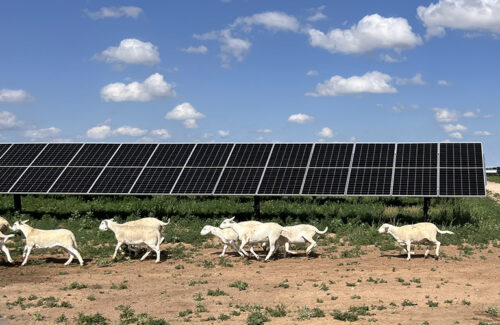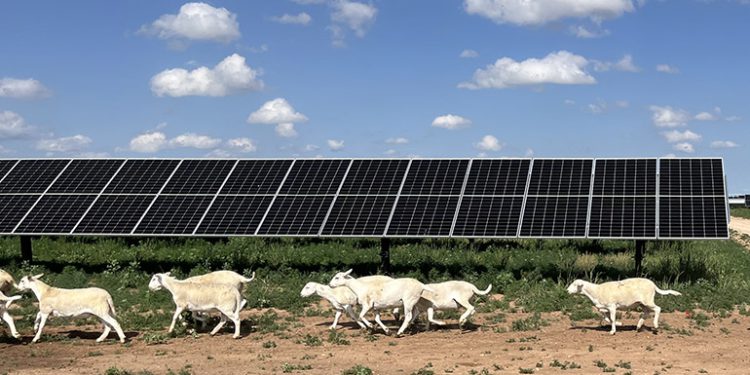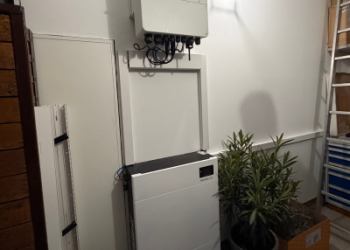
Credit: Vesper Energy
A review by the SUN DAY Campaign of data just released by the Federal Energy Regulatory Commission (FERC) reveals that the combination of solar and wind accounted for 88% of new U.S. electrical generating capacity added in the first eight months of 2025. In August, solar alone provided two-thirds of the new capacity, marking two consecutive years in which solar has held the lead every month among all energy sources. Solar and wind each added more new capacity than did natural gas. Within three years, the mix of all renewables may top 40% of installed capacity.
Solar was two-thirds of new generating capacity in August and 73% year-to-date
In its latest monthly “Energy Infrastructure Update” report (with data through August 31, 2025), FERC says 48 “units” of solar totaling 2,702 MW were placed into service in August, accounting for two-thirds (66.4%) of all new generating capacity added during the month. That represents the second-largest monthly capacity increase by solar in 2025 — behind only January when 2,945 MW was added.
The newest facilities include the 517.3-MW Outpost Solar & Storage Project in Webb County, TX; the 280.0-MW Gibson Solar Project in Gibson County, IN; the 254.0-MW Ridgely Energy Farm in Lake County, TN; the 204.0-MW Luna Valley Solar Project in Fresno County, CA; and the 200.0-MW Flat Fork Solar Project in Monroe County, AR.
The 505 units of utility-scale (i.e., >1-MW) solar added during the first eight months of 2025 total 19,093 MW and were almost three-quarters (73.4%) of the total new capacity placed into service by all sources.
Solar has now been the largest source of new generating capacity added each month for two years straight: September 2023-August 2025. During that period, total utility-scale solar capacity grew from 91.82 GW to 156.20 GW. No other energy source added anything close to that amount of new capacity. Wind, for example, expanded by 11.16 GW while natural gas’ net increase was just 4.36 GW.
Renewables were 88% of new capacity added year-to-date
For the first eight months of 2025, the combination of solar and wind (plus 4 MW of hydropower and 3 MW of biomass) was 88.0% of new capacity while natural gas provided just 11.9%. The balance of net capacity additions came from oil (20 MW) and waste heat (17 MW).
Solar + wind are almost a quarter of U.S. utility-scale generating capacity; all renewables combined are over a third
Utility-scale solar’s share of total installed capacity (11.62%) is now almost equal to that of wind (11.82%). If recent growth rates continue, utility-scale solar capacity should equal and probably surpass that of wind in the next “Energy Infrastructure Update” report published by FERC.
Taken together, wind and solar constitute nearly one-fourth (23.44%) of the U.S.’s total available installed utility-scale generating capacity.
Moreover, almost 29% of U.S. solar capacity is in the form of small-scale (e.g., rooftop) systems that are not reflected in FERC’s data. Including that additional solar capacity would bring the share provided by solar + wind to more than a quarter of the nation’s total.
With the inclusion of hydropower (7.59%), biomass (1.06%) and geothermal (0.31%), renewables currently claim a 32.4% share of total U.S. utility-scale generating capacity. If small-scale solar capacity is included, renewables are now more than one-third of total U.S. generating capacity.
Solar is still on track to become the second largest source of U.S. generating capacity
FERC reports that net “high probability” net additions of solar between September 2025 and August 2028 total 89,953 MW — an amount almost four times the forecast net “high probability” additions for wind (23,223 MW), the second-fastest growing resource.
FERC also foresees net growth for hydropower (566 MW) and geothermal (92 MW) but a decrease of 126 MW in biomass capacity.
Meanwhile, natural gas capacity would expand by 8,481 MW and nuclear power would add just 335 MW, while coal and oil are projected to contract by 23,564 MW and 1,581 MW respectively.
Taken together, the net new “high probability” net capacity additions by all renewable energy sources over the next three years – i.e., the Trump Administration’s remaining time in office — would total 113,708 MW. On the other hand, the installed capacity of fossil fuels and nuclear power combined would shrink by 16,329 MW.
Should FERC’s three-year forecast materialize, by early-fall 2028, utility-scale solar would account for 17.1% of installed U.S. generating capacity — more than any other source besides natural gas (40%). Further, the capacity of the mix of all utility-scale renewable energy sources would exceed 38%. Inclusion of small-scale solar — assuming it retains its 29% share of all solar — could push renewables’ share to over 41% while that of natural gas would drop to about 38%.
“Notwithstanding impediments created by the Trump Administration and the Republican-controlled Congress, solar and wind continue to add more generating capacity than fossil fuels and nuclear power,” noted the SUN DAY Campaign’s executive director Ken Bossong. “And FERC foresees renewable energy’s role expanding in the next three years while the shares provided by coal, oil, natural gas, and nuclear all contract.”
News item from the SUN DAY Campaign
















